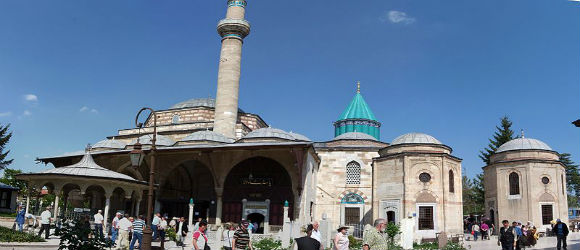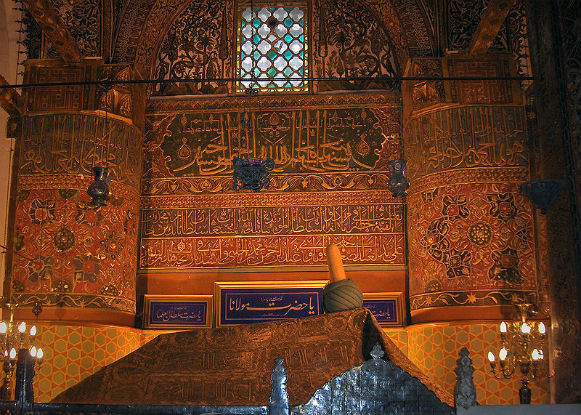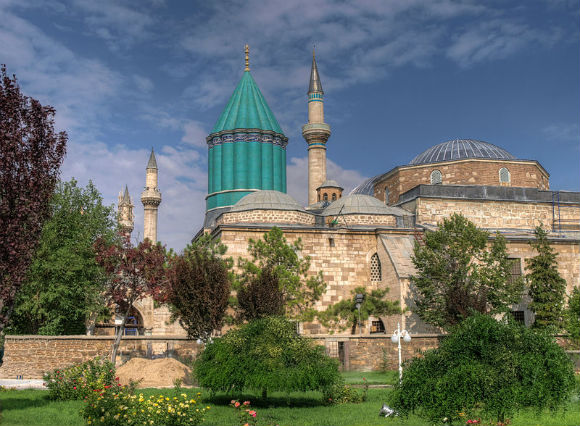The Mevlana Museum also known as the Green Mausoleum or Green Dome, is the original lodge of the Mevlevi Whirling Dervishes, a mystical Sufi Muslim group. It containes the tomb and shrine of the Mevlana, or Rumi, which remains an important place of pilgrimage.
History
Sultan ‘Ala’ al-Din Kayqubad, the Seljuk sultan who had invited Mevlana to Konya, offered his rose garden as a fitting place to bury Baha’ ud-Din Walad (or Bahaeddin Veled), the father of Mevlana, when he died in 1231. When Mevlana himself died on December 17, 1273, he was buried next to his father.
Mevlana’s successor Hüsamettin Çelebi built a mausoleum (Kubbe-i-Hadra) over the grave of his master. The Seljuk construction, under architect Behrettin Tebrizli, was finished in 1274. Gürcü Hatun, the wife of the Seljuk Emir Suleyman Pervane, and Emir Alameddin Kayser funded the construction.
The cylindrical drum of the of the dome originally rested on four pillars. The conical dome is covered with turquoise faience. Several sections were added until 1854. Selim I decorated the interior and performed the woodcarving of the catafalques.
A decree by Ataturk in September 1925 dissolved all Sufi brotherhoods in Turkey. On April 6, 1926, another decree ordered that the Mevlana mausoleum and dervish lodge be turned into a museum. The museum opened on March 2, 1927.
Special permission granted by the Turkish government in 1954 allowed the Mawlawi dervishes of Konya to perform their ritual dances for tourists for two weeks each year. Despite government opposition the order has continued to exist in Turkey as a religious body. The tomb of Rumi, although officially part of a museum, attracts a steady stream of pilgrims.
What to See
The dervish lodge (tekke) includes a semahane, where the ritual sema or whirling ceremony takes place, a sadirvan for ritual ablutions, a library, living and teaching quarters, and the mausoleum housing the tomb of Celaleddin Rumi, founder of the sect and later awarded the honorable title of Mevlana. His epitaph reads: “Do not seek our tombs on this earth – our tombs are in the hearts of the enlightened.”
The mausoleum room is highly ornamented with Islamic script and enameled reliefs, and contains the tombs of several of the more important figures of the dervish order. The main tomb enclosed behind a silver gate crafted in 1597 is that of Mevlana. The tomb of his father, Bahaeddin Veled, is upright and adjacent to his son’s, a position that signifies respect.
The adjoining room, or the semihane, is now a museum of Mevlana memorabilia displaying musical instruments and robes belonging to Mevlana, along with Selçuk and Ottoman objects like gold-engraved Korans from the 13th century. Among the fabulous ancient prayer rugs is the most valuable silk carpet in the world.
Mevlana Museum, Konya,




An affordable venue with a real sense of peace, calm, spirituality and love. This instantly hits you in the gardens, but there is more to come.
In the 1930's, Ataturke disbanded the sufi order and turned the monestry's into museums. Konya is the centre of the Mevlana order and it is here that you get a real sense of what…
Fantastic experience !!!!
Also make sure you attend one of the dancing sessions of the dervishes dancers, unforgettable
Discovering something new and different. Living conditions were an eye opener! The gardens and surrounds were beautiful and pleasant to spend time in.
No trip to Konya will be complete unless you visit the mausoleum of Mevlana Celaleddin Rumi, the Sufi founder of Mawlawi Order.
The complex is located in the city center, has a nice rose garden with WC, coffee and gift shop. The complex has served as a school to excel mawlawi order for centuries until it has turned into a…
I visited on part of a tour of Turkey. It is an old structure, very well maintained. inside are tombs of Mevlana and several of his students and some family. There is also a small museum with artistically impressive copies of Quran and other items. The garden is a good spot to relax also. I suspect this destination would have…
The main museum had some very old Korans and the outside buildings had rooms devoted to the Dervish sect which were very interesting. I did wear a headscarf but I noticed many tourists did not. Great value for money.
somewhat interesting but skippable
Konya was an ok city but definitely would give it a miss in the future
Worth a visit if you are at all interested in the Whiling Dervishes. There is a series of windows in the courtyard which depict the life of a Dervish and there is the building which houses the remains of Mevlana.
I mentioned to a Turkish friend that I was going to visit Capadoccia, Konya and Side. She smiled and said "Kapadokya and Side are natural beauties and Konya is the spiritual beauty". She was right! We stayed only one night and 2 days in Konya, and I didn't find the city to be particularly special in general, but Konya is…
Rami is the author of beautiful poems and an uplifting inclusive philosophy. It is exciting to consider that you can visit the site where Rumi's teachings and traditions began. But when it comes to the "museum" aspect of the place, it focuses on the items of ritual. I am not Muslim, so I know I have an outsider's perspective –…